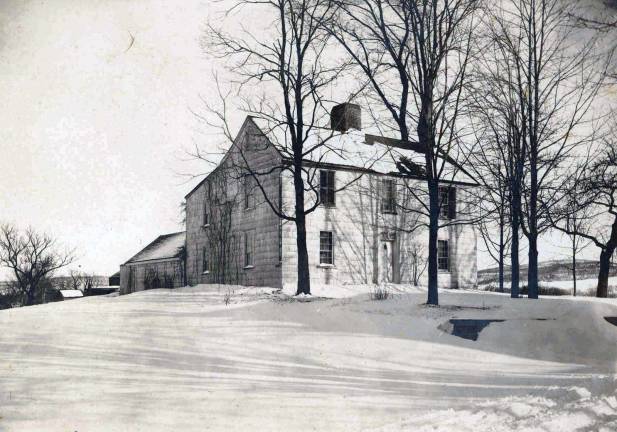The story behind Daniel Burt's Shingle House

The Shingle House - located on Forester Avenue in Warwick this year celebrates 250 years. If you drive by today you may do a double take. It is definitely showing its age.
Several areas around the house have been opened up to evaluate its difficulties, which is the reason for those white patches on the corners.
Owned by the Historical Society since 1916, the Shingle House is Warwick’s most precious treasure. Here is a legacy that has been left to us that few towns in Orange County can boast about, which, along with the society’s nine other buildings in the heart of the Village, are virtually what make Warwick distinctive and different from other towns.
Shirley Gordon, who with her late husband Seymour, were docents of the Shingle House and the adjoining Sly Barn for about ten years, notes that: “Every fourth grader will remember the tour he or she took to the Shingle House to see the way the early settlers lived; their method of cooking on the fireplace with the bee hive oven which reminded them of a pizza oven and the cone of sugar, which brought to mind Sugar Loaf Mountain.”
Daniel Burt and his son Dan Jr. were its untrained architects and builders. They began to construct the house in 1764 but it took them five years to finish. They had trees to fell, the shingles and the beams to make by hand, nails and other hardware to forge, while at the same time planting and harvesting their crops, and even helping to build Warwick’s first log church during those same years. The church was located on the corner across from Daniel’s house on Galloway Road, on land now known as the Hallowed Ground.
Daniel Burt first found land in the Warwick in 1746 when he moved to what is now known as Pioneer Farm on Route 94S. After building a log cabin, he tried to make a go of homesteading. His nearest neighbors were a tribe of Minsis Indians whose village was virtually in his back yard.
But the remoteness of the area discouraged him. It took his family many days riding their horses from Ridgefield, Conn., to try to even locate him in a place covered in dense forest with no real roads and only a handful of other settlers. They convinced him to leave this wilderness and return to Connecticut.
He returned to Warwick a second time, and built a mill on the creek in Bellvale. But when it was washed out in a storm he exchanged that property for 200 acres in what wasn’t even a village yet, building his house on Galloway Road, which, to this day, is still owned and lived in by his descendants, the McFarland family.
When Daniel Jr. was thinking about marrying Martha Bradner, he and his father chose a knoll on his land on what was then called Burt’s Lane. It is now Forester Avenue.
The original Shingle House was of "salt box" design with a center chimney similar to the houses in Ridgefield, Conn. It was an English core design, brought from England, where such houses were known as “yeoman cottages.”
According to Michael Bertolini, curator of the Historical Society: “The refined quality of the raised paneling in the two front rooms of the house is unlike any others of that age in this area, showing that the builders brought with them a knowledge of a better quality of living and building.”
The house is a gem, and when up and running, is filled with furniture and features totally authentic to the period in which it was built. Its value to present and future generations is inestimable. It is vital that it be preserved.
The society is sponsoring a Historic Trail Walk, a fun way to test your knowledge of Warwick’s historic buildings and contribute to the restoration of the Shingle House.
• You can purchase the clues at the Farmers’ Market (every other Sunday) or at the Buckbee Center ( 2 Colonial Ave.; open weekdays 9 a.m. to 1 p.m.) $10 per person or $25 for a family of four.
• Take a walk through the village with the clues, fill in the answers to the clues and return the back page of the flyer to the Buckbee Center with your name and address.
• A drawing will be held at the annual George Washington Day Picnic on July 26.
• If you have completed the questions, and your name is chosen, you could win $250 as first prize, with assorted second, third and fourth prizes.
• For further information, call the Historical Society 986-3236.
Warwick Village Historian Jean Beattie May contributed this essay.